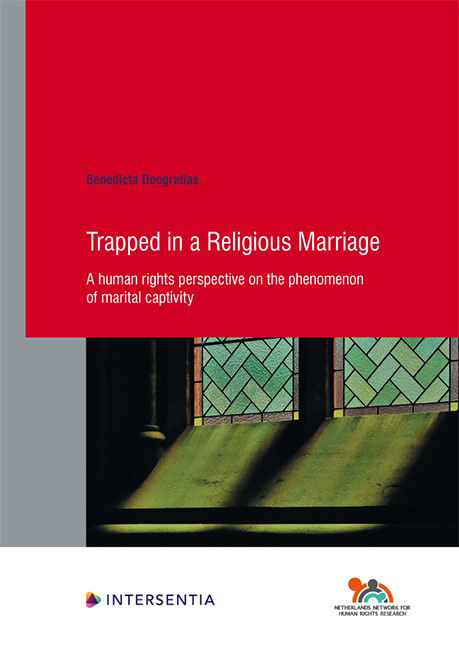Book contents
- Frontmatter
- Contents
- List of Frequently Used Abbreviations
- Chapter 1 Introduction to Marital Captivity
- Chapter 2 Religious Barriers to Divorce
- Chapter 3 Marital Captivity in the Netherlands
- Chapter 4 Marital Captivity and the Freedom of Religion
- Chapter 5 The Right to Divorce
- Chapter 6 The Trapped Spouse’s Rights
- Chapter 7 Violence Against Women
- Chapter 8 Conclusions
- Bibliography
- Curriculum Vitae
- Human Rights Research Series
Chapter 4 - Marital Captivity and the Freedom of Religion
Published online by Cambridge University Press: 22 December 2020
- Frontmatter
- Contents
- List of Frequently Used Abbreviations
- Chapter 1 Introduction to Marital Captivity
- Chapter 2 Religious Barriers to Divorce
- Chapter 3 Marital Captivity in the Netherlands
- Chapter 4 Marital Captivity and the Freedom of Religion
- Chapter 5 The Right to Divorce
- Chapter 6 The Trapped Spouse’s Rights
- Chapter 7 Violence Against Women
- Chapter 8 Conclusions
- Bibliography
- Curriculum Vitae
- Human Rights Research Series
Summary
The religious aspects inherent in the phenomenon of marital captivity also need to be given consideration. Religious communities have an interest in solving the issue in accordance with prevailing religious rules and values. Where the religious rules require the cooperation of the other spouse to the divorce, cooperating or not cooperating to a religious divorce may be considered as a reflection of the concerned spouse’ s religious convictions. Besides the State-Church relations that prevail within the respective State, it is also important to take the religious matters into account when considering means and measures to address marital captivity.
Particularly for secular States, State-Church relations are a critical factor that should be taken into consideration when considering how the State can respond to the phenomenon of marital captivity. There are three principles underlying the notion of secularism, namely: the separation of State and Church, neutrality of the State and the freedom of religion. These principles apply in parallel to one another and shape the boundaries of the State's discretion, competences and jurisdiction vis à vis those of the Church. The first two principles have been elaborated upon within the context of the Netherlands in Chapter 3 above. The mere understanding of the principles of ‘separation of State and Church’ and ‘State neutrality’, however, does not sufficiently answer the question of whether State intervention in cases of marital captivity is, or is not, permissible, particularly more so for secular States. The notions of ‘separation of state and church’ and ‘neutrality of the State’ merely define the power arrangements between the State and the Church. Thus, a complementary inquiry is necessary in order to establish whether the State's intervention is permissible. In this respect, the right to freedom of religion plays an important role as it provides a framework for analysing the obligations, competences and boundaries of the State. It enables to determine the permissibility of State intervention in religious matters. Understanding the right to freedom of religion, its scope and limitations is thus crucial for the process of finding solutions to marital captivity.
This Chapter, therefore, elaborates further on the scope and limitations of the right to freedom of religion and whether a State's intervention to prevent and end situations of marital captivity may constitute an interference with this right.
- Type
- Chapter
- Information
- Trapped in a Religious MarriageA Human Rights Perspective on the Phenomenon of Marital Captivity, pp. 97 - 150Publisher: IntersentiaPrint publication year: 2020

